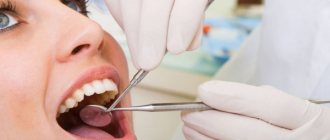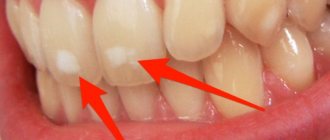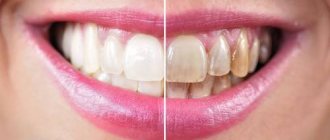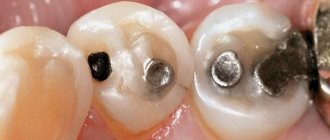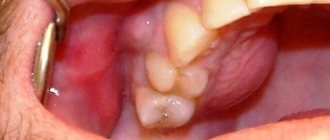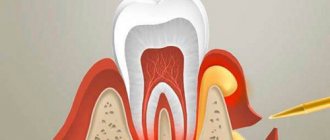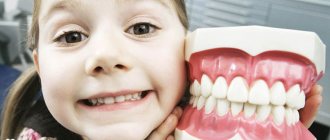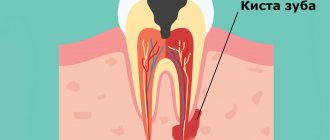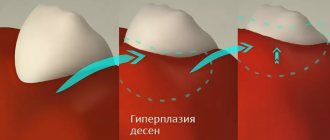The problem occurs several weeks before the eruption of a baby or permanent tooth. The appearance of a cyst is indicated by a bluish-purple spot (hematoma). This is due to difficulty in tooth eruption.
An eruption cyst is a type of soft tissue benign tumor that appears when a tooth has already begun to erupt through the gum. Scientists and doctors have not agreed on why it occurs. The most likely causes: infection, trauma, improper development of teeth, which causes a lack of space for the “newbie”. In addition, it may be a consequence of caries and improper care.
Eruption cysts occur during the growth of baby teeth or, more often, at 6–9 years of age, when permanent teeth emerge. The fact is that, due to its anatomical structure and location, the chewing group of teeth is the most difficult to erupt.
If you notice a large formation in your baby’s mouth, in the place where a tooth should appear, consult a doctor. Do not resort to self-medication under any circumstances. Infusions, rinses and even strong antibiotics most likely will not help, but ruining a child’s health in this way will cause serious harm.
If you contact a specialist, treatment can follow one of two scenarios. In the most favorable option, the doctor will advise giving the child toys, special teethers, crackers - everything that the baby can chew. This will help break through the mucous membrane.
In difficult situations, surgery may be necessary. Then the surgeon will cut the gum under local anesthesia. This will make teething easier.
It is forbidden to try to cut or tear the mucous membrane on your own; you can cause a serious infection or injure your baby.
Causes of Teething Cysts in Children
During teething, a hematoma is formed; it occurs due to the fact that the tooth cannot break through the mucous membrane and thereby injures the gums and ruptures blood vessels. The longer the formation is in the oral cavity, the larger its size; in addition, the amount of swelling will depend on the group affiliation of the tooth.
The main causes of the tumor:
- pulpitis;
- caries;
- periodontitis;
- improper tooth treatment or lack thereof;
- eruption injuries.
The baby’s body tries to limit the source of infection, which is why a dense protective capsule is formed, which eventually develops into a cyst. The occurrence of such formations is quite common. An infection caused by carelessness, an unsuccessful attempt to chew hard food, a fall that led to a tooth injury - all this can serve as a starting point for gum inflammation and further development of a cyst.
Another fairly common mistake parents make, which can lead to the appearance of a tumor during teething, is negligence in caring for baby teeth.
It is generally believed that you should take serious care of your dental health after changing them. Since there is no point in treating non-permanent baby teeth - they will soon fall out. In fact, not taking things seriously leads to many problems. Any gum diseases and oral infections should be eliminated in a timely manner, regardless of how many teeth the baby has and whether they are permanent or not.
Blue gums
Another common phenomenon, especially in young children, is blue discoloration of the gum tissue. It often occurs during the eruption of the first, baby teeth. During this process, inevitable damage occurs to tissues penetrated by a huge number of blood vessels of different sizes. As a result, blood can enter the soft tissue, leading to the formation of a small hematoma.
That is why, if a baby has a hematoma or bruise in a place where a new tooth is expected to appear soon, there is no cause for concern. However, in all other cases it is recommended to show the child to the dentist. The cause of blueness may be an inflammatory process. It is usually preceded by diseases such as gingivitis or stomatitis.
It is important that such complications usually occur in children with weakened immune systems. Also, the health of teeth and gums is greatly influenced by compliance with the rules of daily care. Due to the abundant accumulation of plaque and stone, most ailments appear; this is especially dangerous at an early age, when the enamel is not yet strong enough.
Complications with cyst growth
Tooth trauma, advanced caries, nasopharyngeal or periodontal disease, dental malformations - one or more of these factors can lead to the development of a cyst. The danger is that the cyst grows unnoticed. It usually does not hurt and at the initial stage does not cause discomfort or reaction of the lymph nodes. With further development, suppuration and various unpleasant sensations may appear. But even if there is no pus, the cyst is very dangerous. Therefore, do not delay treatment.
A cyst can lead to intoxication of the body due to the fact that waste products of harmful microorganisms enter the blood. The consequence of this can be headaches, high fever and, in the worst case, sepsis.
In addition, complications are caused by local problems - phlegmon, abscesses, osteomyelitis. These complications are inflammatory in nature and often occur when the cyst suppurates. The spread of pus can lead to destruction of the jaw bones, damage to the internal organs of the digestive system, liver, and heart.
It is impossible to avoid the appearance of a cyst, but if you properly care for baby and permanent teeth and treat infections in a timely manner, you can reduce the likelihood of its occurrence. In addition, periodic visits to the dentist will allow you to notice the problem at an early stage, when treatment will be as simple and easy as possible for the body.
Causes of black spots on gums
If your baby is under three years old, there is a chance that the formation that has alerted you is an erupting tooth. Its appearance is accompanied by swelling and redness of the gums, sometimes it can darken significantly. You can gently touch the lump with your finger after washing your hands. When pressed, it feels like
then under the relatively soft gum there is a hard formation. This is a new tooth being felt.
It is believed that teething is a physiological process and does not require consultation with a dentist. However, if the gums are very swollen, have a bright red or bluish color, and the child reacts to manipulations in the mouth extremely painfully, this is a reason to consult a specialist.
Black spots on a child's gums may be evidence of a disease. With insufficient oral hygiene, weakened immunity, diseases accompanied by the consumption of medications that reduce the body's resistance, a pathological process may develop in the mouth, for example:
- gingivitis. This is a disease of the gums in which they become inflamed, swollen, and change color. There may be an unpleasant odor from the baby's mouth. Symptoms of gingivitis are unpleasant for a child - itching, burning sensation and soreness of the gums. Possible refusal to eat. The disease requires consultation with a doctor! He will prescribe treatment that is appropriate for the baby’s age and condition.
- stomatitis. The disease's symptoms are similar to gingivitis and also manifests itself as a white coating on the oral mucosa. It can be caused by either a fungus (“thrush”) or bacterial or viral agents. Precisely because there can be several causative agents of the disease, consultation with a pediatrician is mandatory - he will prescribe a medicine that will act specifically on the cause of the disease.
If a dark spot appears on the gum of an older child, one can also assume the traumatic nature of the formation. Ask him if he hit his face on something, perhaps got into a fight with someone, causing a “bruise” on his gum.
Cyst treatment
A dental cyst is treated either with therapeutic methods or with surgical intervention. The first ones are used in simple cases.
Surgery involves two types of operations - cystotomy and cystectomy. In both cases, local anesthesia is used. With cystomy, only the anterior wall of the cyst is removed. This is a less traumatic option, as it allows you to preserve the rudiments of permanent teeth during surgery on milk teeth.
Cystectomy is performed if the size of the cyst does not exceed 1.5 cm. This operation is more difficult, but postoperative recovery is much faster.
No matter how small and insignificant the swelling may seem to you, contact your dentist. This will avoid complications. And the problem will be resolved more easily and in a short time. Remember that no rinses, infusions or other folk remedies can guarantee recovery.
Why does a child have black plaque on his teeth?
The main problem with the appearance of Priestley plaque on teeth is not that it causes bad breath, looks unsightly, or cannot be removed independently without the help of a hygienist. Priestley's plaque is a signal that something has changed in the child's body, due to which non-dangerous bacteria began to actively multiply, creating deposits. And for high-quality treatment and prevention of the development of diseases, it is necessary to find out why black plaque forms on the teeth, the reasons for the appearance of beneficial living conditions for bacteria.
Possible causes of plaque:
➢
diabetes;
➢
genetic feature or hereditary predisposition;
➢
thyroid diseases;
➢
incorrectly selected hygiene products;
➢
parasite infection.
Dysbacteriosis.
Disruption of the gastrointestinal tract can occur due to malnutrition, food poisoning, immaturity of the digestive system, taking antibiotics or chronic diseases of the stomach, liver, and intestines.
Caries.
Due to the fact that parents usually do not brush their baby’s first teeth, yellow plaque begins to accumulate on the enamel, which over time can cause caries. Irregular or insufficiently high-quality tooth brushing by the child himself also leads to the formation of caries. Carious lesions create a favorable environment for the growth of bacteria, which causes Priestley plaque to appear on baby teeth.
Dehydration.
Due to dehydration due to various reasons, the body cannot produce enough saliva to wash the teeth and remove food particles. Because of this, bacteria begin to multiply faster, and a dark plaque forms on the child’s teeth. Therefore, it is important to ensure that your baby gets enough fluids, especially in hot weather or during illness.
Hypoplasia of tooth enamel.
Some children have underdeveloped top layer of enamel. It is weakened and unable to perform a protective function.
Disorders of dental development in the prenatal period.
Dental buds may be damaged during development due to viral infections suffered by the mother, calcium deficiency, iron deficiency, or taking certain medications.
Improper functioning of the immune system.
Malfunctions in the immune system can affect the body's ability to suppress bacterial activity.
Malocclusion.
If a child has a malocclusion, the load on the jaw when chewing is distributed unevenly, which is why some of the teeth receive increased load, but are cleansed with solid food: carrots, apples. And unused teeth become covered with plaque.
How to avoid complications
To avoid missing a cyst in the early stages, check with your dentist at least once every six months, especially if your child has chronic pulpitis or periodontitis. The occurrence of cysts is most likely between the ages of 6 and 12 years, especially during the formation of the first molars in the lower jaw.
Teach your child proper and regular oral hygiene. This will reduce the likelihood of inflammation and caries in both milk and permanent teeth. For this, use high-quality children's toothpaste for a specific age. Asepta has developed Baby, Kids and Teens pastes that take into account the dental needs of children of different ages. For the little ones, specialized Asepta wet wipes designed in the form of finger pads are suitable - wipe the gums after each feeding.
It is necessary to treat infections and caries in a timely manner so that they do not lead to the formation of a cyst in the future.
When to see a doctor
When a child is teething, his immune system is weakened. Symptoms that parents attribute to teething may be hiding a viral or bacterial infection. Don't wait for it to go away on its own and see a doctor if:
- the child has a temperature above 38.5℃;
- he became lethargic and drowsy;
- refuses food;
- Vomiting and diarrhea began.
So:
- When teeth are being cut, the baby’s gums may be painful and swollen; this is a normal phenomenon; otherwise the tooth cannot pass through the tissues of the jaw and gums;
- When the gums erupt, they look swollen, reddened, then they turn white, and a hole forms in the place of the future tooth;
- You should not use a gel to relieve pain in your baby’s gums unless absolutely necessary; if the pain bothers the child greatly, then choose gels without anesthetics or combination drugs;
- If, against the background of teething, the child has a high fever, he is very restless or, on the contrary, lethargic, refuses to eat, if vomiting or diarrhea begins, consult a doctor.
(0 ratings; article rating 0)
Share Share Share
